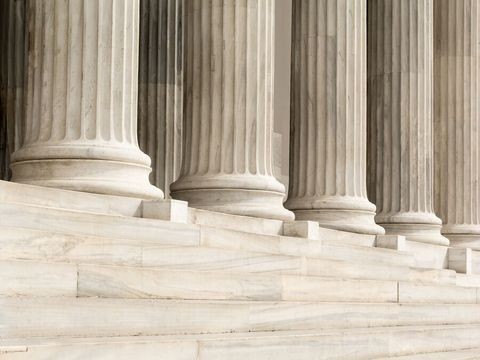The Biden Administration Begins: The Pandemic, Economy, and Changing Course
Client Alert | 8 min read | 01.18.21
The Executive Orders, Biden American Rescue Plan, and COVID Bill
With less than two days before the inauguration, President-elect Biden has already announced new coming Executive Orders, a pandemic-fighting American Rescue Plan, and components of an upcoming Biden COVID-19 bill. The Biden administration is willing to use the full power of the executive branch to address the pandemic, start an economic recovery, and change prior policies on immigration, environmental protection, and more. The proposed agenda is sure to move swiftly and will require the support of an equally divided Congress or the use of the budget reconciliation bill in late spring for a Democratic-only vote. The following is a summary of what we will be watching closely in the First 100 Days.
I. The Executive Orders
The Biden administration has announced a series of Executive Orders (EOs) that the new president will issue from January 21 through February 1, 2021. They are a combination of new policy positions and directions to the new administration to shift course on a variety of issues. The following is a summary of the currently announced upcoming EOs, which were previewed by incoming White House Chief of Staff Ron Klain:
- The focus of new Biden EOs will be on four major problems – (1) the COVID-19 pandemic; (2) the economic downturn; (3) racial injustice; and (4) climate change.
- The U.S. will require the wearing of masks on all federal property and seek to require them on all interstate transportation for 100 days.
- The U.S. will take action to accelerate a “Buy America” policy aimed at bringing back and creating manufacturing for critical products in the U.S.– such as COVID-19 vaccine supplies and personal protective equipment. President-elect Biden will create a “national supply chain commander” position within the government.
- The U.S. will seek to reverse Trump environmental policy, rescind permission to drill on federal lands, and pull back from offshore drilling and oil exploration.
- The U.S. will rejoin the Paris Climate Accord (and former Secretary of State John Kerry will lead this effort and have a seat on the National Security Council).
- The U.S. will end the travel ban on predominantly Muslim countries
II. The Biden American Rescue Plan and Coming COVID Legislation
The Biden administration is also going to come out of the gate seeking to use EOs and the full power of the executive branch to address the pandemic and the economy, as well as going to Congress with a new COVID-19 relief bill. On January 14, 2021, President-elect Joe Biden announced a major legislative proposal, urging Congress to adopt a $1.9 trillion package to address the COVID-19 pandemic and the related economic downturn. The proposal focuses on COVID-19 measures, such as (a) establishing a national vaccination program, (b) increasing reimbursement for vaccines, (c) expanding testing, and (d) investing in domestic manufacturing of certain pandemic related medical supplies, including personal protective equipment. It also focuses on boosting aid to individuals, small businesses, and state and local governments affected by rising infection rates and correlated shutdowns.
The following is a summary of the key Biden American Rescue Plan provisions:
A. Pandemic Response and Other Health Care Measures
- Invest $20 billion to establish a national vaccination program that will work closely with local authorities, including launching community vaccination centers and deploying mobile vaccination units for use in hard-to-reach areas.
- Invest $50 billion to expand COVID-19 testing, ensuring tests are available to all Americans for free. The legislation includes purchasing rapid tests that provide quicker results, expanding lab capacity so more tests can be processed, and implementing regular testing protocols at schools, prisons, long-term care facilities, and local governments.
- Recruit 100,000 public health workers to conduct vaccine outreach and contact tracing in the immediate term. But in the long-run, the roles would transition into community health roles.
- Ensure vaccines and supplies are distributed equitably, and expand healthcare services for underserved communities by opening more community health centers and investing in health services on Native American land.
- Provide funding for states to deploy strike teams to long-term care facilities experiencing COVID-19 outbreaks, and vaccinating prisoners and prison staff.
- "Dramatically increase" the U.S.'s virus sequencing work, surveillance, and outbreak analytics capacity to better monitor and respond to new strains of the virus.
- Invest $30 billion in the Disaster Relief Fund, which provides supplies and protective gear, and an additional $10 billion investment to expand domestic manufacturing of pandemic supplies. This effort would be in addition to President-elect Biden’s commitment to use the Defense Production Act to produce more supplies.
- Increase investments in the development, manufacturing, and purchase of therapies to ensure wide availability and affordability of effective treatments for COVID-19 and its long-term health impacts.
- Provide full federal reimbursement for critical emergency response resources to states, local governments, and Native American tribes, including deployment of the National Guard.
B. Relief for Small Businesses and State and Local Governments - $440 billion
- Establish a grant program for small businesses with a $15 billion federal investment.
- Create a small business lending program with a $35 billion federal investment.
- Offer state, local, and tribal governments $350 billion in emergency funding.
- Provide public transit agencies $20 billion in relief.
- Invest $20 billion to support tribal governments in their pandemic response.
C. Cybersecurity Provisions to Respond to Recent Federal Breeches – $11 billion
- Invest $9 billion in the Technology Modernization Fund to bolster Cybersecurity and Information Security Agency (CISA) and General Services Administration (GSA) cybersecurity projects.
- Increase funding for the Information Technology Oversight and Reform Fund by $200 million to support the Chief Information Security Officer and U.S. Digital Service.
- Provide $300 million in funding for Technology Transformation Services in the General Services Administration.
- Provide $690 million to the CISA to improve federal incident response and monitoring systems.
D. Employment Provisions
The American Rescue Plan includes several proposals affecting the employment practices and legal obligation of private sector U.S. employers. The following are among the most significant of the recommendations.
- Minimum Wage. The Plan proposes to increase the federal minimum wage to $15 an hour. In support of this initiative, Biden proclaimed that “No one working 40 hours a week should still be below the poverty line.” This would require an amendment to the Fair Labor Standards Act. The current federal minimum wage is $7.25 per hour.
- Unemployment Insurance. The Plan would modify and extend last year’s CARES Act supplement to unemployment insurance (UI) benefits in the amount of $400 per week, through September 30, 2021. This would replace the current $300 per week supplement, scheduled to expire in March. The Plan also calls for extending last year’s Pandemic Unemployment Assistance program for self-employed individuals.
- Paid Leave. The Plan calls for the provision of 14 weeks of paid family and medical leave for eligible individuals through 2021. It is likely that these benefits would be modeled on the benefits provided in the CARES Act and Families First Coronavirus Response Act (FFCRA), in a package that would eliminate last year’s exemptions from the paid leave requirements for employers with very small (under 50) and large (over 500) numbers of employees. Reports suggest that this package would extend paid leave entitlements to an additional 106 million Americans. The Plan would reportedly provide up to $1,400 a week in paid leave to eligible employees through a “full wage replacement” program up to $73,000 of annual income.
- COBRA Premiums. The Plan would provide for a tax credit for 100 percent of the amount of COBRA premiums paid by individuals who become eligible for COBRA as a result of a job loss.
- OSHA. Reports suggest that Biden will ask Congress to authorize the Occupational Safety and Health Administration (OSHA) to issue a COVID-19 Protection Standard that covers a broad set of workers, so that workers not typically covered by OSHA, like many public workers on the frontlines, also receive protection from unsafe working conditions and retaliation.
E. Tax Provisions
The Biden American Rescue Plan includes expansion of three popular tax credits that, along with the stimulus checks also proposed as part of this plan, are aimed at putting more cash in taxpayer’s wallets as quickly as possible.
- Child Tax Credit. The Plan would increase the existing child tax credit to $3,600 for children under 6, and $3,000 for children between 6 and 17 (the prior credit excluded 17-year-old children). The Plan also provides that the full amount of the credit be refundable.
- Earned Income Tax Credit. The Plan contains a proposal that is similar to that in the HEROES Act. It contemplates raising the credit and the income limit for eligibility significantly, as well as allowing workers over the age of 65 to claim the credit. These changes will be in effect for 2021 only.
- Child and Dependent Care Tax Credit. Expansion of this credit under the Plan provides a credit equal to 50 percent of qualified child care expenses of $4,000 for one child and $8,000 for two or more children. The credit would be refundable and fully available for families making up to $125,000 and partially available for families making between $125,000 and $400,000.
III. The Forecast and the Road Ahead
The Biden administration team will be issuing many more EOs, policy statements, proposed regulations, and plans in the coming weeks. We will track all of them and digest and bring the ones that might affect your business to you. Despite the incoming Biden administration’s enthusiasm to deliver another round of federal stimulus measures, the legislation’s future is less than certain. President-elect Biden is going to have to balance Congressional Democratic priorities, particularly those in the Progressive wing of the party, that want more generous legislation, with Congressional Republicans’ return to fiscal conservatism. Unless Democrats pursue the legislation by way of the Budget Reconciliation process, which would only require a simple majority in the Senate of 51 votes (50 Senate Democrats with Vice President Kamala Harris as the tiebreaking vote), President-Elect Biden and Democratic leadership will need the support of at least 10 Republicans. Although a number of Senate Republicans have indicated support for new relief measures in 2021, it is improbable that the Biden Plan is adopted wholesale without significant negotiation. There will be work ahead for the Biden White House, Congress, federal agencies, and all of us in navigating our way out of a once-in-a-century pandemic and into a brighter future for us all! Stay tuned!
Contacts
Insights
Client Alert | 5 min read | 12.12.25
Eleventh Circuit Hears Argument on False Claims Act Qui Tam Constitutionality
On the morning of December 12, 2025, the Eleventh Circuit heard argument in United States ex rel. Zafirov v. Florida Medical Associates, LLC, et al., No. 24-13581 (11th Cir. 2025). This case concerns the constitutionality of the False Claims Act (FCA) qui tam provisions and a groundbreaking September 2024 opinion in which the United States District Court for the Middle District of Florida held that the FCA’s qui tam provisions were unconstitutional under Article II. See United States ex rel. Zafirov v. Fla. Med. Assocs., LLC, 751 F. Supp. 3d 1293 (M.D. Fla. 2024). That decision, penned by District Judge Kathryn Kimball Mizelle, was the first success story for a legal theory that has been gaining steam ever since Justices Thomas, Barrett, and Kavanaugh indicated they would be willing to consider arguments about the constitutionality of the qui tam provisions in U.S. ex rel. Polansky v. Exec. Health Res., 599 U.S. 419 (2023). In her opinion, Judge Mizelle held (1) qui tam relators are officers of the U.S. who must be appointed under the Appointments Clause; and (2) historical practice treating qui tam and similar relators as less than “officers” for constitutional purposes was not enough to save the qui tam provisions from the fundamental Article II infirmity the court identified. That ruling was appealed and, after full briefing, including by the government and a bevy of amici, the litigants stepped up to the plate this morning for oral argument.
Client Alert | 8 min read | 12.11.25
Director Squires Revamps the Workings of the U.S. Patent Office
Client Alert | 8 min read | 12.10.25
Creativity You Can Use: CJEU Clarifies Copyright for Applied Art
Client Alert | 4 min read | 12.10.25
Federal Court Strikes Down Interior Order Suspending Wind Energy Development




